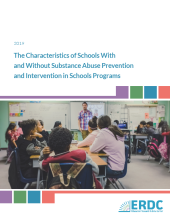Substance Abuse Prevention and Intervention in Schools Programs (known as SAPISP or SAP) have existed in Washington public schools since the early 1990s. The programs, referred to here as SAP, provide substance abuse prevention and intervention services to enhance the classroom environment and enable students to reach their academic and personal potential. Intervention specialists provide services to students in grades 5 through 12 in schools identified as having high numbers of students at risk for substance abuse. According to the SAP program manual, services are intended to “(a) promote the skills and attitudes necessary to resist pressures to use alcohol, tobacco, and other drugs, (b) help students avoid antisocial behavior that may disrupt learning, (c) encourage students to reduce the substance use for which they were referred, and (d) remove barriers to school success.”
Part of research grant from the U.S. Department of Education awarded to Washington state’s Education Research and Data Center (ERDC) in 2015, this study uses school level administrative data to look at the characteristics of Washington schools with SAP programs and those schools without such programs. This descriptive analysis addresses the following questions:
- What are the characteristics of schools that provide SAP intervention programs and those that do not?
- Is there any change in school-level substance abuse and academic outcome measures among SAP and non-SAP schools, over time?


